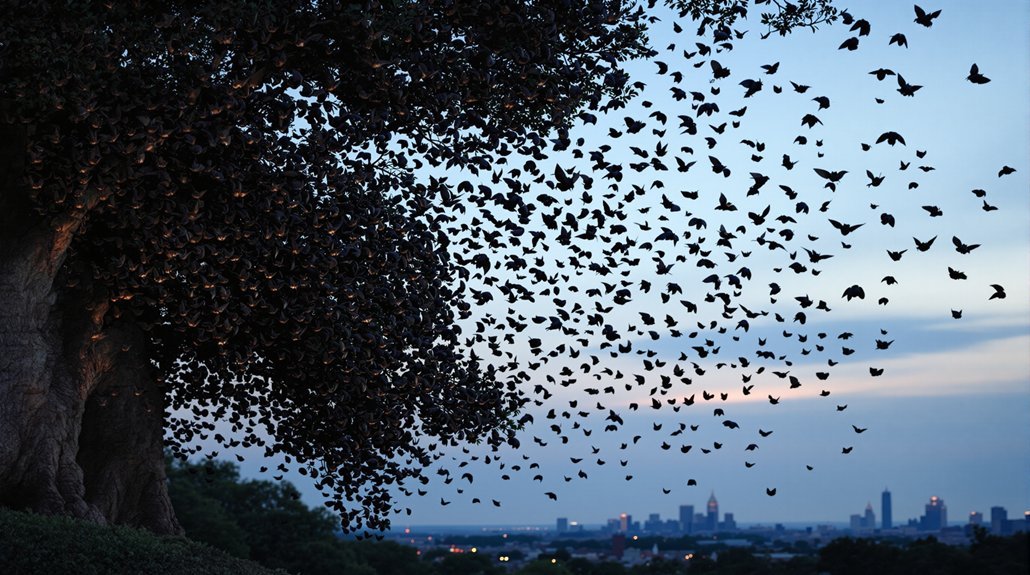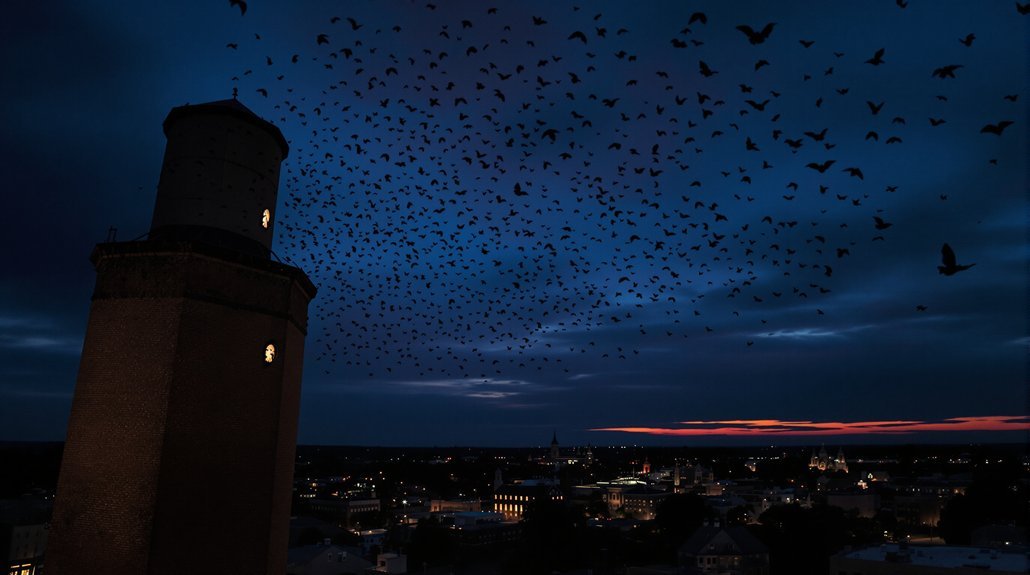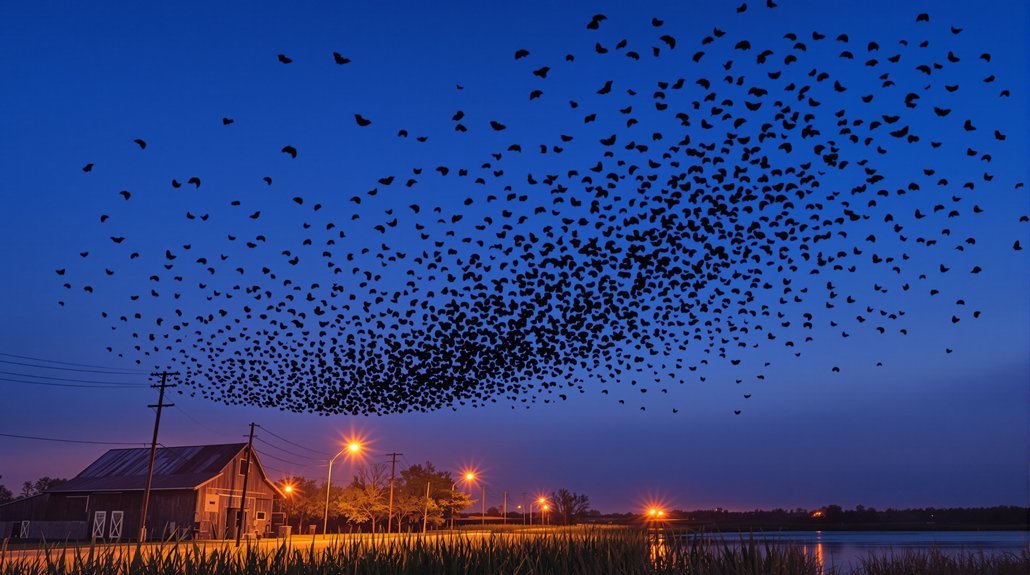Bats in Des Moines typically emerge from hibernation in late spring. This usually occurs in May when temperatures start to warm up. Their peak activity happens from June through August. During these months, bats are most likely to be seen flying at dusk, searching for insects. As temperatures drop in the fall, their activity declines. There are many interesting facts about bats and their behaviors throughout the year that can be explored further.
Key Article Highlights
- Bats in Des Moines typically emerge from hibernation in late April to early May as temperatures begin to rise.
- Peak bat activity occurs from June through August, aligning with warmer weather and abundant insect populations.
- Evening hours, particularly around dusk, are the best times to observe bats as they become active at night.
- Bats prepare for hibernation in autumn, leading to decreased activity in September and October.
- Weather conditions, such as warmth and dryness, significantly influence the timing and frequency of bat sightings.
Understanding Bat Species in Des Moines

What types of bats can be found in Des Moines? In this city, there are several bat species. The most common include the little brown bat and the big brown bat. Each species has its own unique traits and habits. People often believe in bat myths that paint these creatures as dangerous. In reality, bats are generally harmless and help control insect populations. Species differences are important to understand, as not all bats behave the same way. Some bats prefer to roost in trees, while others find shelter in buildings. Learning about these differences can help dispel myths and promote a better understanding of bats. Recognizing their seasonal behaviors, such as emergence months, can aid in effective bat management and protection efforts. Bats follow specific behavioral patterns related to their seasons, which can influence the best times for exclusion or observation.
The Importance of Bats in the Ecosystem

Why are bats considered essential to the ecosystem? Bats play an essential role in maintaining balance in nature. They help control insect populations through their diet, eating thousands of insects each night. This natural pest control reduces the need for chemical pesticides, benefiting both crops and human health. Bats use bat echolocation to navigate and hunt for food in the dark, showcasing their unique adaptations to nocturnal behavior. Their presence also supports plant growth, as they pollinate flowers and disperse seeds. This interaction is crucial for many plants that rely on bats for reproduction. Overall, bats are important allies in promoting biodiversity and ensuring healthy ecosystems in Des Moines and beyond. Their contributions significantly impact agriculture and environmental health.
Seasonal Behavior of Bats

Bats exhibit distinct seasonal behaviors that align with changes in temperature and food availability. During spring, bats emerge from their cave habitats as insects become more plentiful. They seek out roosting sites in trees or buildings to rest during the day. Summer is the peak season for activity, as bats hunt for food at night. As temperatures drop in autumn, bats prepare for winter. They may return to caves or other sheltered areas to hibernate. During this time, they rely on stored fat for energy. In winter, bats remain inactive, conserving energy until warmer weather returns. Understanding these seasonal patterns helps in conserving bat populations and their essential roles in the ecosystem.
Factors Influencing Bat Emergence
As winter ends and spring approaches, various factors influence when bats emerge from their roosts. Temperature is a key factor, as warmer weather encourages bat flight. Roost location also plays a role; bats in urban areas may emerge earlier than those in rural settings. Additionally, the availability of food sources, such as insects, affects their activity. Light conditions at dusk can influence emergence timing as well.
| Factor | Influence on Emergence | Description |
|---|---|---|
| Temperature | Higher temps promote flight | Warmth triggers activity |
| Roost Location | Urban vs. rural differences | Urban bats may emerge sooner |
| Food Availability | Influence on activity | More insects lead to earlier flights |
| Light Conditions | Dusk timing | Affects the start of emergence |
| Weather Patterns | Storms delay activity | Poor conditions keep bats roosted |
Typical Bat Activity Timeline
Bats in Des Moines follow a typical activity timeline through the seasons. They migrate to warmer areas and return in spring to breed. The peak months for bat activity usually occur in the summer when they are most active.
Seasonal Migration Patterns
The seasonal migration patterns of bats in Des Moines are influenced by temperature and food availability. As temperatures drop in autumn, bats prepare for their hibernation period. They look for warm, safe places to rest during the cold months. In spring, when temperatures rise and insects become plentiful, bats emerge from hibernation. They follow specific migration routes to find food and suitable roosting sites. During this time, activity increases as bats hunt for insects at dusk. By late summer, bat populations may gather in larger numbers before starting their migration again in fall. Understanding these patterns helps in recognizing when bats are most active in Des Moines throughout the year.
Breeding and Maternity Season
During the breeding and maternity season, bat activity in Des Moines becomes more pronounced. This period usually starts in late spring when bats emerge from their hibernation habits. As temperatures rise, they seek suitable roost selection locations. Many female bats gather in warm, safe places to give birth to their young. These roosts are often found in attics, trees, or caves. The mother bats care for their pups, providing warmth and food. During this time, male bats may also be more active, searching for mates. Understanding this season helps local residents recognize the importance of bats in the ecosystem. Their role in controlling insect populations is critical, making it essential to protect their habitats during breeding.
Peak Activity Months
What months see the highest levels of bat activity in Des Moines? Typically, bat activity peaks from late spring to early fall. April through October is when these creatures are most active. During this time, bats engage in nocturnal flights, searching for food and mates. As temperatures rise, the warm weather encourages more bats to emerge from their roosts. Roost detection becomes easier for those interested in observing these animals. By mid-summer, many young bats join their parents in the evening skies. This period is essential for their growth and learning. Understanding the peak activity months helps people know when to watch for bats, enhancing their appreciation for these important nocturnal animals in the ecosystem.
The Role of Temperature in Bat Activity
How does temperature influence bat activity? Temperature plays a key role in how bats behave. When temperatures rise, bats are more active. They often leave their roosts to hunt for food and socialize. Warmer weather encourages bat vocalizations, as they communicate more with each other. This communication helps them find mates and establish territory. Conversely, when temperatures drop, bats tend to stay in their roosts. They conserve energy and reduce their activity levels. Cold weather can lead to fewer vocalizations, as bats become less social. Thus, temperature directly affects both roosting behaviors and the interactions among bats. Understanding this relationship helps researchers predict when bats will be most active in Des Moines.
How Weather Patterns Affect Bats
Weather patterns greatly impact bat behavior beyond just temperature. Rainfall, humidity, and wind can influence bat foraging. When it rains, insects become less active. This leads to fewer food sources for bats, causing them to forage less. On the other hand, dry weather can increase insect activity, allowing bats to hunt more effectively. Additionally, seasonal changes affect cave hibernation. As temperatures drop in winter, bats seek caves to stay warm. Unusual weather patterns can disrupt their hibernation cycle. For example, a warm spell in winter may wake bats too early, leading to food shortages. Understanding these weather effects is essential for conservation efforts and habitat protection for bats in Des Moines.
Best Times to Observe Bats
The best times to observe bats in Des Moines are during the evening hours. Bats are most active at dusk as they hunt for insects. Seasonal changes also affect when and how often they can be seen.
Evening Observations Preferred
When is the best time to see bats in Des Moines? The evening is the ideal time for bat observation. Bats are nocturnal creatures, meaning they are active at night. They leave their roosts to hunt for food as the sun sets. This time aligns with their roosting habits, where they rest during the day in trees, buildings, or caves. As dusk approaches, they emerge to begin their nocturnal foraging. Observers can often see bats flying low over water or open fields, catching insects in the air. This behavior makes evening the perfect time for watching these fascinating animals. Those interested in bats should plan their outings around this time for the best chance to observe them in action.
Seasonal Activity Patterns
Observing bats in Des Moines can vary throughout the seasons. The best times for bat detection are typically during warmer months. Bats are more active in late spring and summer when they emerge from urban roosts to hunt for insects. As temperatures drop in fall, their activity decreases.
| Season | Best Time for Bat Detection | Notes |
|---|---|---|
| Spring | May – June | Bats emerge from hibernation |
| Summer | June – August | High activity levels |
| Fall | September – October | Decreasing activity |
Understanding these seasonal patterns helps observers plan their outings effectively. Those interested in bats should focus on warmer months for the best chances to see these fascinating creatures.
Common Myths About Bats
Bats are often misunderstood creatures that evoke fear and curiosity. Through myth busting, many bat misconceptions can be clarified. Common myths include:
- Bats are blind: In reality, bats have good vision and can see in low light.
- All bats are dangerous: Most bats are harmless and help control insect populations.
- Bats are flying rodents: Bats are more closely related to primates than to rodents.
These myths create unnecessary fear around bats. Understanding the truth about these animals is essential for appreciating their role in the ecosystem. Bats contribute to pollination and pest control, making them important for the environment. By dispelling these misconceptions, people can learn to coexist peacefully with bats in their communities.
How to Create a Bat-Friendly Environment
Creating a bat-friendly environment can benefit both the local ecosystem and the community. Bats play an important role in controlling insect populations, which helps protect crops and gardens. To support bats, people can plant native flowers and trees. These plants attract insects, which make up a bat’s diet. Providing suitable roost sites is also essential. This can be done by installing bat houses in yards or leaving old trees standing. Avoid using pesticides, as they can harm bats and reduce their food supply. By creating a safe space for bats, communities can enjoy the benefits of natural pest control while promoting biodiversity. Simple actions can make a big difference for these valuable creatures.

